Face-Off: Sonos One Beats HomePod, Google Home Max and Amazon Echo
After evaluating sound quality, design, smart features and more, we chose the Sonos One as the smart speaker to beat.

You're in the market for a smart speaker that not only delivers great sound but also helps you around the house. A good smart speaker (and the assistant powering it) should let you control lights and other smart home devices, as well as perform other tasks, such as looking up recipes, movie times, news and more. We put the top smart speakers — the Apple HomePod, Google Home Max, Sonos One and Amazon Echo — through a multiround test to see which is the best for your home.
To determine a winner, we assigned a certain number of points to each round (Design, Sound Quality, Streaming Music, Smart Home Compatibility, Assistant Smarts, and Value) and awarded each speaker a set number of points based on how well it performed in that round. While every smart speaker we tested has its share of strengths, the Sonos One came out on top.
Design
Of the four speakers, the HomePod is the most attractive, but Apple isn't taking any bold chances with its design.
The cylindrical HomePod is wrapped in a mesh-like cloth that's acoustically transparent. On top is a round, plastic cap that also acts as a touch panel for interacting with Siri, adjusting the volume and more.
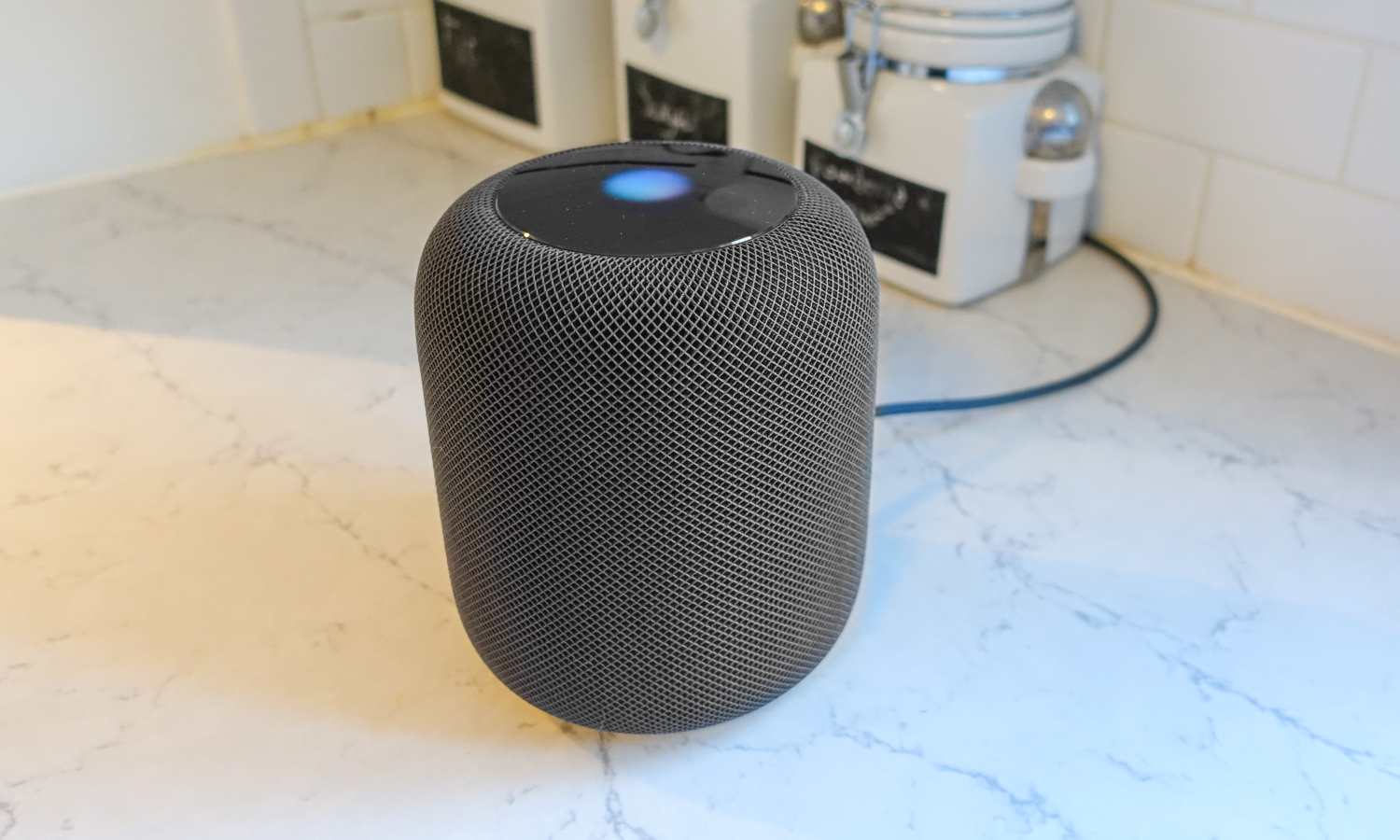
But be careful where you place the HomePod: The chemicals in its silicone base can leave a white ring on some wood surfaces, as we found out to our chagrin.
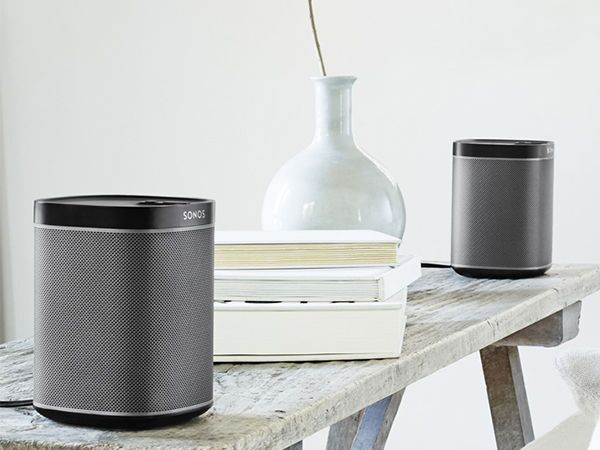
The Sonos One is slightly smaller than the HomePod, and has a hard metal exterior with perforations all around its sides to let sound through. The top also has touch controls, but lacks HomePod's fun LED light show. However, it, too will leave white marks on some wood surfaces, which we also learned the hard way.
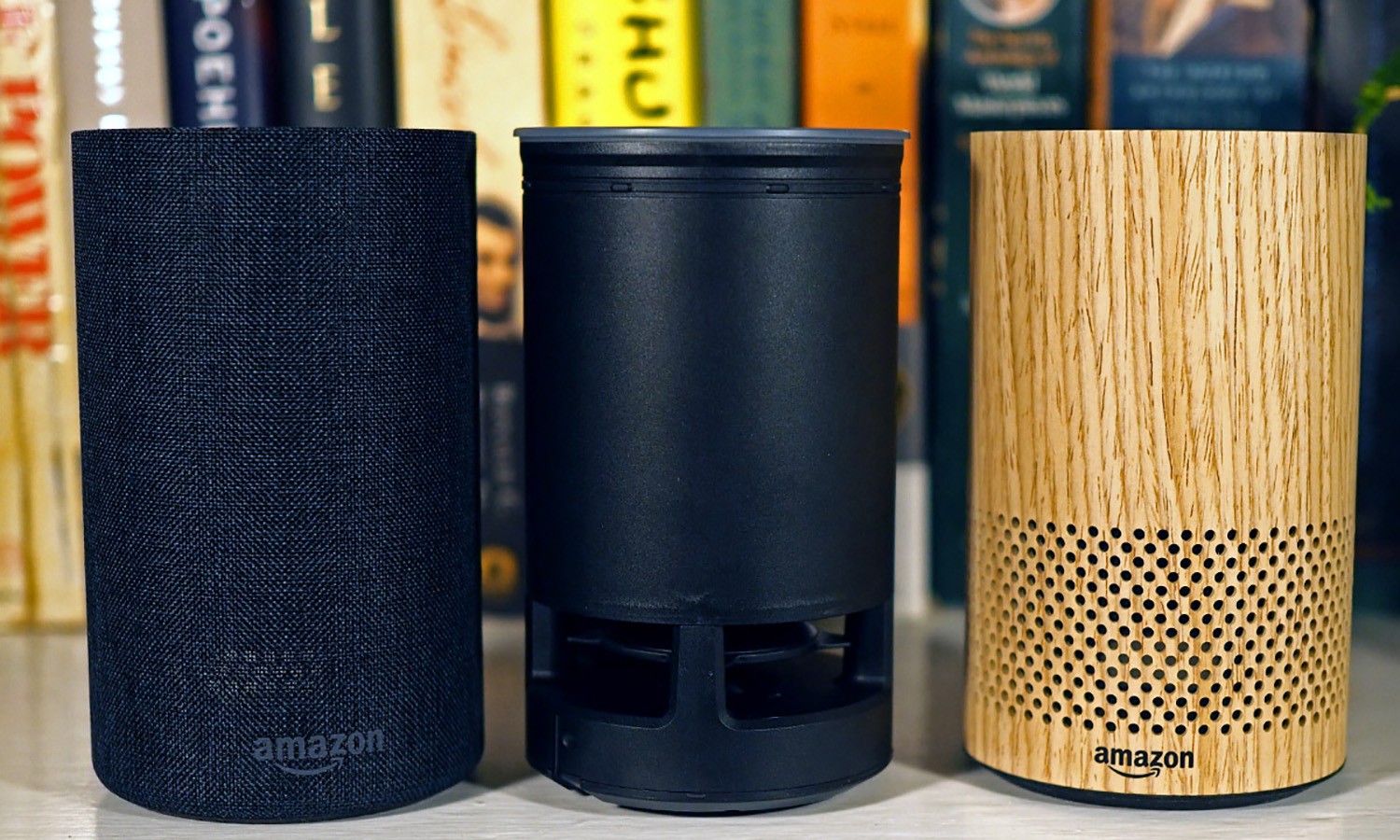
The cylindrical second-generation Amazon Echo (5.9 inches tall and 3.5 inches in diameter) has a cloth-like cover and a hard plastic top with buttons to adjust the volume, activate Alexa and turn off its microphone. Unlike its competition, the Echo's look can be customized with different covers. There are several cloth shells to choose from, as well as two types of wood. LEDs ring the top edge of the Echo. They light up blue when the speaker is listening and red when the microphone is turned off. Of all of the features on the smart speakers we tested, this is the one I liked most, as it provides a clear visual cue.
Get instant access to breaking news, the hottest reviews, great deals and helpful tips.
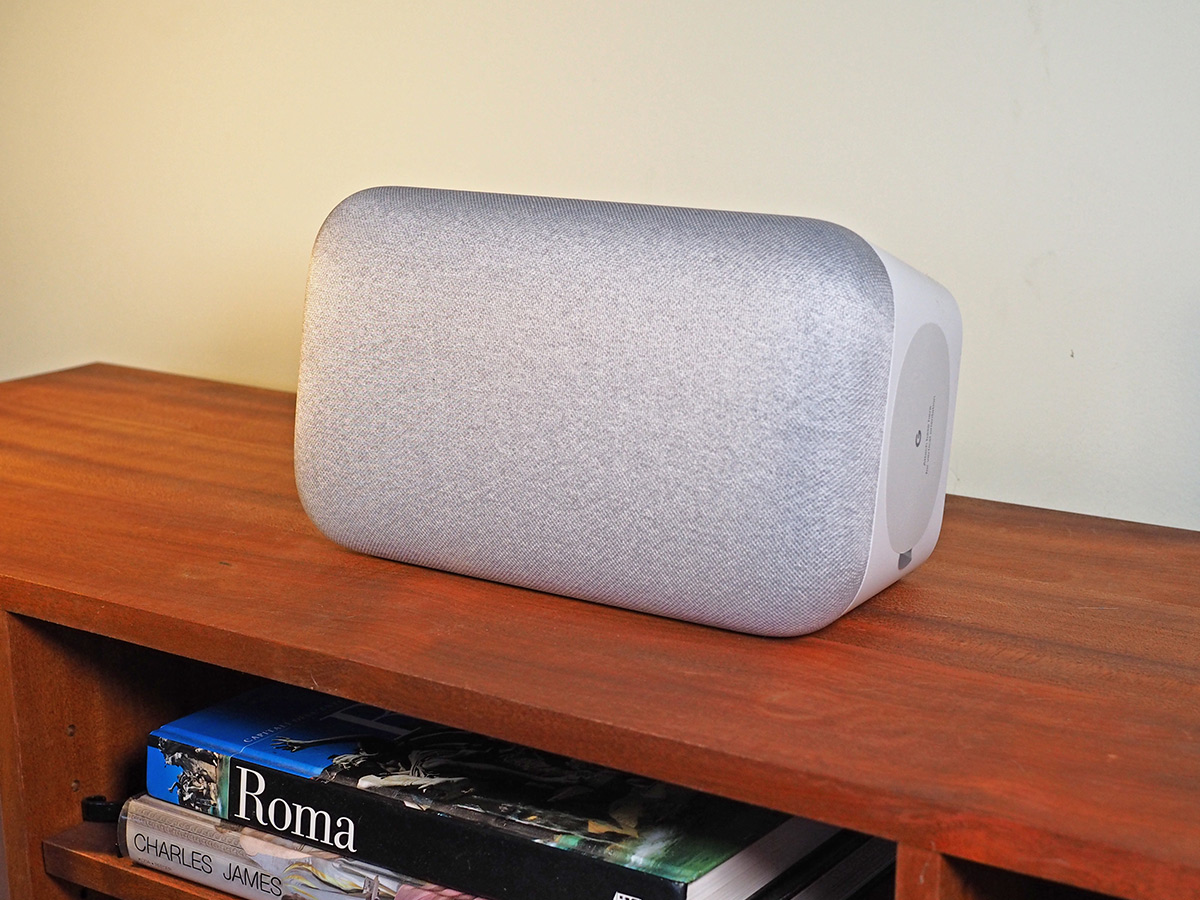
The Google Home Max looks the most like a traditional speaker. It's roughly rectangular, with a fabric covering the front. Four LEDs light up white in the middle of the speaker when it's listening and turn amber when the microphone is turned off.
At 6.8 inches tall and 5.6 inches in diameter, the HomePod is slightly larger than the Sonos One (6.4 x 4.7 x 4.7 inches) but much smaller than the Google Home Max (13.2 x 7.4 x 6 inches), which seems massive sitting next to the other two.
Winner: Amazon Echo.It may not have the most radical design, but I like that you can customize its look with different shells, and its ring of LEDs makes it the easiest to see from across a room. Plus, it won't stain your furniture.
Sound Quality
Above all, a smart speaker must have good sound. And, in the case of the HomePod and the Google Home Max, it has to sound really good to match its $300-plus price.
First, let's take a look under the hood to see what each speaker packs.
Amazon Echo: One 2.5-inch woofer, one 0.6-inch tweeter
Apple HomePod: One 4-inch high-excursion woofer (+/- 21mm), seven horn-loaded tweeters
Google Home Max: Two 4.5 inch high-excursion (+/- 11 mm) dual voice-coil woofers, two 0.7-inch tweeters
Sonos One: One tweeter, one woofer
Including the Echo in this part of the competition is a little unfair, as Amazon's $99 speaker wasn't meant to compete with the high-end audio expected of the HomePod, Google Home Max and Sonos One. Still, the Echo sounds at least as good as the original, and will suffice if you're looking for an inexpensive speaker that's good enough for casual listening.

The HomePod, Google Home Max and Sonos One can all be custom-tuned so that their acoustics are optimized for the room in which they're placed. Apple's and Google's speakers have built-in microphones and do this automatically. The Sonos One requires you to move your iPhone around the room while the speaker plays a tone. It's a much more cumbersome process, and you have to redo this every time you move the Sonos One to a new room.
After all the speakers were set up on my wood cabinet and properly tuned, I played the same assortment of songs through each speaker. I also brought the HomePod and a single Sonos One to the office and had a few colleagues listen to the same tracks on both speakers, streamed from Spotify.
The songs included "Poker Face" by Lady Gaga, "I Left My Heart in San Francisco" by Tony Bennett (with Dave Brubeck), "What's My Name?" by Snoop Dogg, "Nessun Dorma" as sung by Luciano Pavarotti, and "Time Won't Wait" by Jamiroquai.
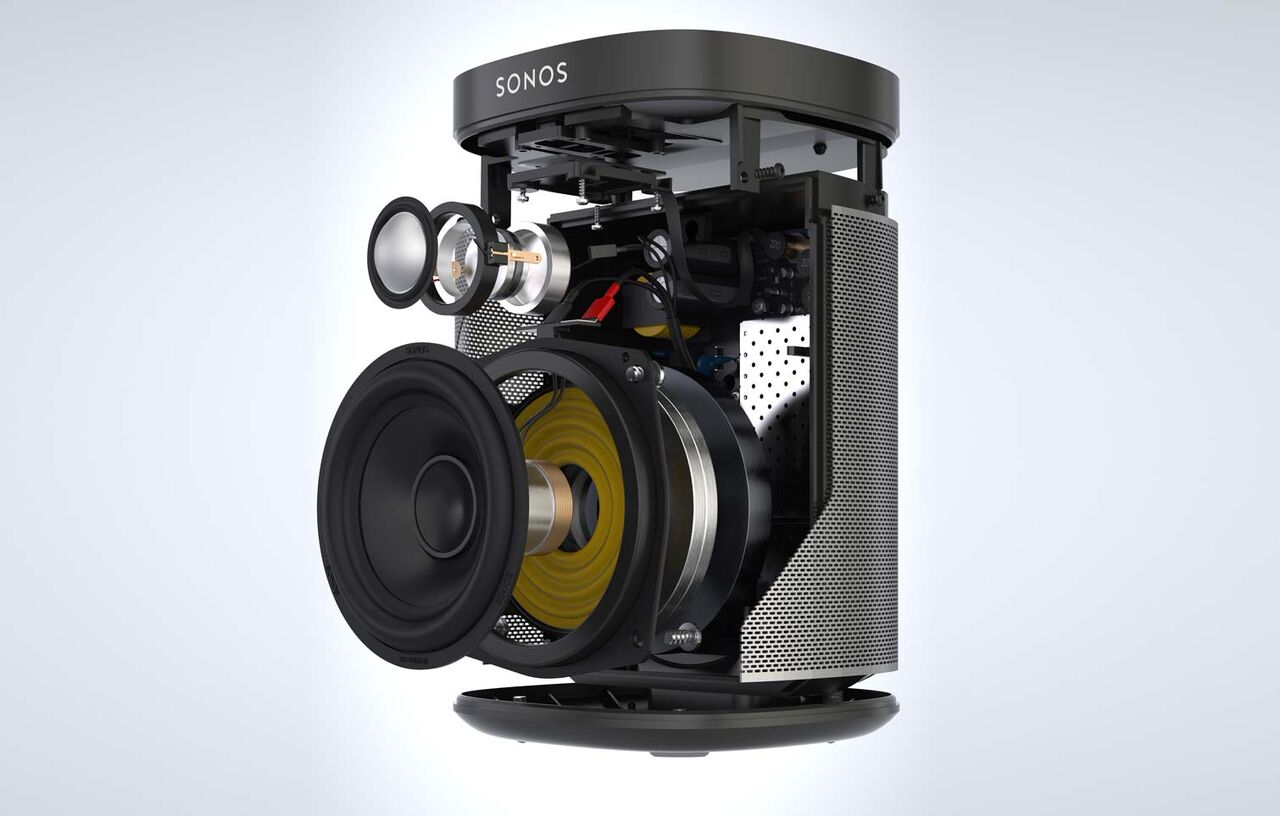
Overall, the HomePod and the Sonos One were the top two performers. Listeners praised the HomePod's stronger and more robust bass, but it came at the expense of higher tones, such as vocals and high-pitched instruments, which sounded muddier, according to one person. While the Sonos One's bass wasn't as pronounced, it was better at rendering the rest of the music.
The HomePod's circular design made it better in terms of room placement; you could listen to it from nearly any angle and there would be little difference in the sound. By contrast, sitting in the front of the Sonos One resulted in a much better listening experience than its back side. Then again, you'd need a pretty long extension cord to put the HomePod in the middle of your room.
Winner: Apple HomePod. The HomePod has more resonant bass than a single Sonos One and sounds good from every angle. But the Sonos excels in midranges, and when you pair two Sonos speakers together, they beat the HomePod.
Music Streaming Sources
A smart speaker can be the best-sounding in the world, but if you can't use it to stream music from the service of your choice, then what good is it?
Using the Sonos One or the Amazon Echo, you can ask Alexa to stream music from Amazon Music, Amazon Music Unlimited, iHeartRadio, Pandora, TuneIn, SiriusXM and Spotify. With the Sonos One, though, you can pause, resume, skip tracks or change volume using 55 other streaming sources through its app.
Google Home Max supports YouTube Music, Pandora, Spotify, Google Play Music, TuneIn and iHeartRadio. However, you can use Chromecast to play songs wirelessly from other sources.
With the HomePod, you're limited to Apple Music, though you can use AirPlay to beam music from other sources on your phone, such as Spotify.
Winner: Sonos One.It gives the greatest flexibility in music sources.
Smart Home Compatibility
If you go on Amazon, you will find hundreds of cheap smart plugs that work with Alexa. That doesn't mean you should buy them. Still, Amazon's assistant works with far more smart home devices than its competitors; it's compatible with more than 4,000 products from 1,200 companies. Google Assistant works with more than 200 brands and 1,500 products, according to its blog.
HomeKit lags well behind both, partly due to Apple's more stringent security requirements. While that's a good thing, it means that adoption has been much, much slower. For example, here's a list of some of our favorite smart home devices and their compatibility with Alexa, Google Assistant and HomeKit.
| HomeKit | Google Assistant | Alexa | |
| Philips Hue Lights | ✓ | ✓ | ✓ |
| Nest Thermostat | No | ✓ | ✓ |
| Ecobee Thermostat | ✓ | ✓ | ✓ |
| Nest Cam | No | ✓ | ✓ |
| Netgear Arlo Camera | No | Coming Soon | ✓ |
| Ring Video Doorbell | No | ✓ | ✓ |
| August Smart Lock | ✓ | ✓ | ✓ |
| Belkin WeMo Plug | With adapter | ✓ | ✓ |
| Lutron Caseta | ✓ | ✓ | ✓ |
| Logitech Harmony | No | ✓ | ✓ |
| Roomba | No | ✓ | ✓ |
| TP-Link | No | ✓ | ✓ |
Winner: Amazon Echo. It works with the most things.
Assistant Smarts
A good virtual assistant can help you perform many tasks around the house, so I tested all four speakers with a variety of tasks:
Making Phone Calls
With the Echo, you can call or message any of your contacts, provided they also have the Alexa app on their smartphone, or an Echo, Echo Dot, Echo Spot or Echo Show. The Google Home Max lets you call any of your contacts, as well as businesses listed in Google's business directory. So, for example, you could say, "Call Ray's Pizza." The Google Home Max also lets you call numbers by speaking the digits.
Neither the Apple HomePod nor the Sonos One supports voice calling; while the latter has Alexa built in, it's one of the few limitations imposed by Amazon on third-party devices.
Winner: Google Home Max. It doesn't limit you to calling just the people in your contacts.
Controlling Your TV
If you have an Amazon Fire TV Stick or an Amazon Fire-enabled TV, you can use the Echo or the Sonos One to control it remotely using your voice. In-app Fire TV skills for Hulu, NBC and Bravo, Showtime, Sony's PlayStation Vue and CBS All Access will also let you control programming within those apps. Alexa now also works with select Vizio TVs, too.
If you have a Chromecast-enabled device, such as a smart TV, you can use the Google Home Max to get Google Assistant to stream content to the TV. Supported channels include HBO Now, Netflix, CBS, the CW and YouTube (something you can't get with Alexa).
You can use both Alexa and Google Assistant to control Logitech's Harmony line of universal remotes. Dish customers can also use Alexa to control their Dish DVRs, tune to specific channels or look up programs by genre, actor, title and more. This feature will also be rolled out to Google Assistant in the coming months.
Unfortunately, you can't use Siri via the HomePod to control an Apple TV or any other TV source.
Winner: Google Home Max.It's pretty close between the Home Max and Alexa, but Chromecast is built into far more TVs than Alexa, making it much more pervasive.
Calendar
Both Google Assistant and Alexa let you look up calendar events and create new appointments via the Google Home Max and the Amazon Echo and Sonos One, respectively. However, Amazon lets you link Google, G Suite, iCloud, Outlook.com,or Office365 calendars, while Google Assistant works only with Google calendars. The HomePod can't read, or sync with, any calendars.
Winner: Amazon Echo/Sonos One. Alexa works with multiple calendars.
Ordering Pizza
Pizza is probably my favorite food, so when I have a hankering for a slice, who do I turn to? I told all three assistants, "I want to order a pizza."
Siri, via the HomePod, suggested several restaurants, gave a rating, distance and the hours of operation. It paused between each suggestion and awaited my assent to keep going. Google Assistant listed three pizza restaurants near me, and then stopped. Alexa offered to add a pizza to my Amazon cart.
Winner: Siri. However, none suggested the best pizza place in my area.
Making Dinner Reservations
For date night with my wife, I tried to make dinner reservations at a local restaurant. First, tried the HomePod, but Siri thwarted my romantic intentions: "I wish I could, but I can't help with reservations here," she said. Both Alexa and Google Assistant use OpenTable to set up a reservation, but it worked correctly only with the Google Home Max. With Alexa, the OpenTable skill kept misinterpreting my request and kept suggesting the wrong restaurants in towns far away from where I was.
Winner: Google Home Max
Setting Timers
Both Google Assistant and Alexa let me set multiple timers and name them. Siri could only set one timer at a time.
Winner: Google Home Max and Amazon Echo.
Looking Up Weather
All three assistants gave me fairly accurate weather reports both for the next day as well as the weekend, but none mentioned that it was going to snow.
Winner: Tie
Looking up directions/sending to phone
How do I get to the Empire State Building? Don't ask Siri on the HomePod; it can't help you. Alexa gave me traffic, estimated time and gave general directions, but only Google Assistant provided specific directions and sent them to my phone.
Winner: Google Home Max
Ordering Cat Litter
I have two cats, so I'm constantly buying more kitty litter. When I asked each smart speaker where I could buy more, the HomePod suggested local pet stores, and gave me their ratings and times they were open. Not surprisingly, Alexa skipped over local options, and offered to add it to my Amazon cart. Google first suggested different litters from Target, which I could get delivered via Google Express. When I didn't like any of the options, it offered to add it to my shopping list.
Winner: Google Home Max. I like that it gave me a host of options and the greatest flexibility when ordering.
Looking Up Recipes
A good smart assistant can also act as a good sous chef, reading off ingredients and instructions as you prepare a meal. In my quest to make a mushroom risotto, Google Assistant came out on top. Even though it mispronounced "risotto," it gave me the option to read off ingredients one by one, or skip ahead to the instructions. Alexa also suggested a recipe, and offered to send it to my phone, but it could only do so when I was using the Echo, and not the Sonos One. If you're looking for Siri to help, you'd better get takeout. My request was answered with "I can't get an answer for that on HomePod."
Winner: Google Home Max and Amazon Echo.
Converting Measurements
All of the smart speakers performed pretty well when I asked them to convert 20 cups into quarts. I'll give the edge to Google, because it was the only speaker that said that “it's about 5 U.S. liquid quarts," as it's not a precise measurement. Also, Alexa has a funny way of pronouncing "quarts." Only Siri got tripped up when I phrased my question as, “What is 20 cups in quarts?" Her response: "I can't get the answer to that on HomePod."
Winner: Google Home Max.
In this round, the Google Home Max came out on top, winning most of the mini-competitions. It was the best at looking up directions, helping with recipes, making calls and controlling your TV. The Amazon Echo came in second, as you can do a few more things with it than you can with third-party Alexa devices, such as the Sonos. The HomePod came in last, as it simply can't do as much as Alexa and Google Assistant.
Value
At $199, the Sonos One cost half as much as the Google Home Max ($399) and nearly as much as the Apple HomePod ($349).
However, Sonos and Amazon are offering a deal in which you can purchase two Sonos Ones for $349 — the price of one HomePod. The Echo is the least expensive of them all, at just $99, but it has the worst sound quality.
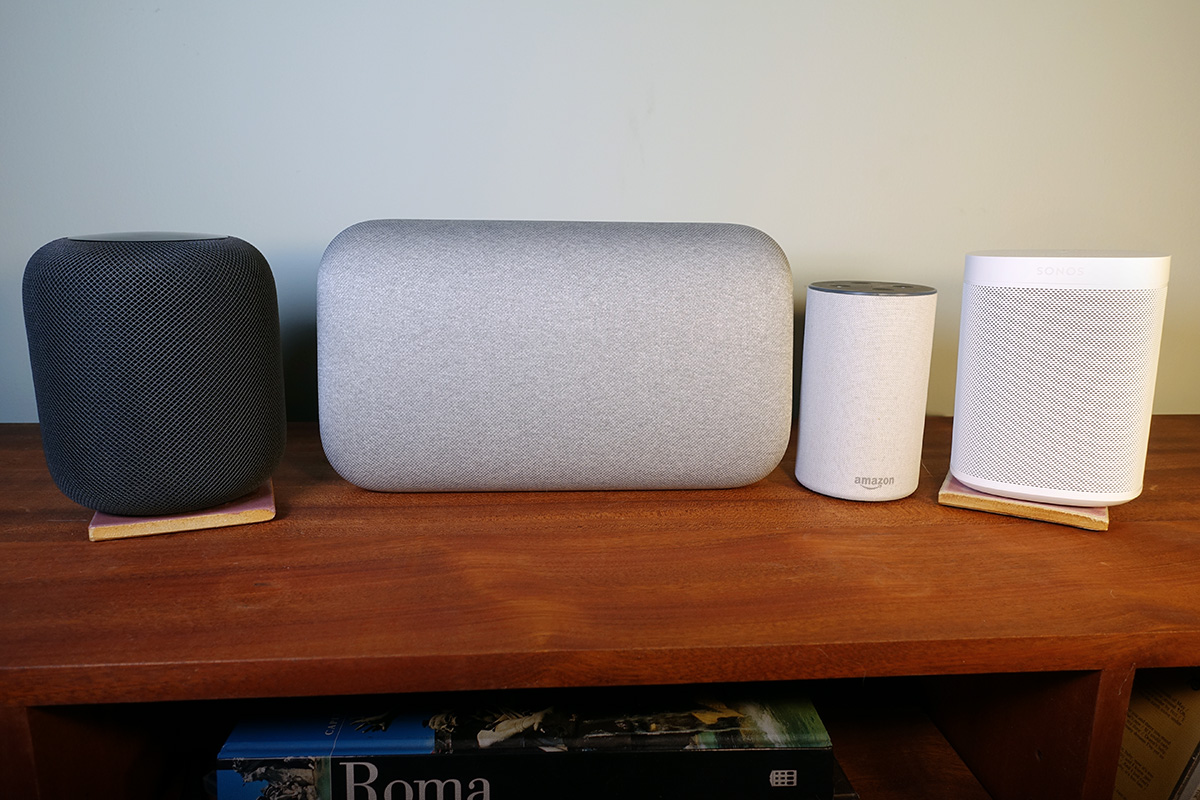
Winner: Sonos One. It's twice as expensive as the Echo, but it delivers sound quality on a par with that of the HomePod. A single speaker sounds great, but two paired in stereo sound even better. You should definitely jump on this deal before it's gone.
| Apple HomePod | Google Home Max | Sonos One | Amazon Echo | |
| Design (10) | 6 | 7 | 6 | 10 |
| Sound Quality (30) | 28 | 25 | 27 | 10 |
| Streaming Music (10) | 2 | 7 | 10 | 9 |
| Smart Home Compatibility (10) | 2 | 7 | 10 | 10 |
| Assistant Smarts (30) | 10 | 28 | 24 | 26 |
| Value (10) | 5 | 4 | 10 | 10 |
| Total Points | 53 | 78 | 87 | 75 |
Overall Winner: Sonos One. Overall, the Sonos One's sound quality was as good as the HomePod's. And, at half the price, the Sonos One is a much better value, too. While it can't do as much with Alexa as the Echo can, it still did more than enough to make it the top smart speaker in this face-off.

Michael A. Prospero is the U.S. Editor-in-Chief for Tom’s Guide. He oversees all evergreen content and oversees the Homes, Smart Home, and Fitness/Wearables categories for the site. In his spare time, he also tests out the latest drones, electric scooters, and smart home gadgets, such as video doorbells. Before his tenure at Tom's Guide, he was the Reviews Editor for Laptop Magazine, a reporter at Fast Company, the Times of Trenton, and, many eons back, an intern at George magazine. He received his undergraduate degree from Boston College, where he worked on the campus newspaper The Heights, and then attended the Columbia University school of Journalism. When he’s not testing out the latest running watch, electric scooter, or skiing or training for a marathon, he’s probably using the latest sous vide machine, smoker, or pizza oven, to the delight — or chagrin — of his family.
-
cwoodphotos This is probably the best review of smart speakers I've read. Being somewhat of an audio perfectionists and having worked in high end audio equipment design and manufacturing, I appreciate the thoroughness. As the late Gordon Holt of Stereophile Magazine once said, "if you don't have good midrange, you have nothing". Actually, you have boom/tweet. The SONOS would seem to have it all in terms of the best octave to octave balance.Reply -
fireitup913 It is clear from the pictures you are not using the silicone pad under the Google Home Max. I believe you confirmed this in your article about checking smart speakers on a wood surface for marks. These rubber/silicone pads isolate the speaker and reduce low-end vibration transfer; this affects sounds quality. This is why almost all speakers have them or come with them. Google just made theirs for either speaker orientation. If you buy a pair of regular bookshelf speakers they will come with similar pads to stick on. They are typically referred to as "isolation pads" and have a very real affect on sound quality as they help stop vibration transfer. You can find many articles and forums about this and people noting the increase in sold quality, especially if the speaker was on a hard surface. This will most likely negatively the Google Home Max's sound quality especially since its shown on a hard wood surface where its going to have vibration transfer . Considering every other speaker had their pads because they are permanently attached, that is a disadvantage to the Max and may have affected its audio quality score.Reply -
pavpev I could be going mad but how did the Sonos score 10 in Smart Home Compatibility? I don't believe it has any function here, shouldn't that be a zero? That would make Google Max the winner (just)Reply -
phydrean Biased. 3x the weight on speaker. It's a smart speak, so the emphasis should be on smart. Amazon wins hands down. Look at your own chart!Reply
Suggest a more objective viewpoint, but then you will have to return any money received by Sonos for the analysis.
I like Tom's Guide, but we all saw right through this...you tried to tweak it in Google's and Sonos's favor and tried to look objective, but it became obvious in the end, you were not. How many Sonos's did you get to keep for this report?
